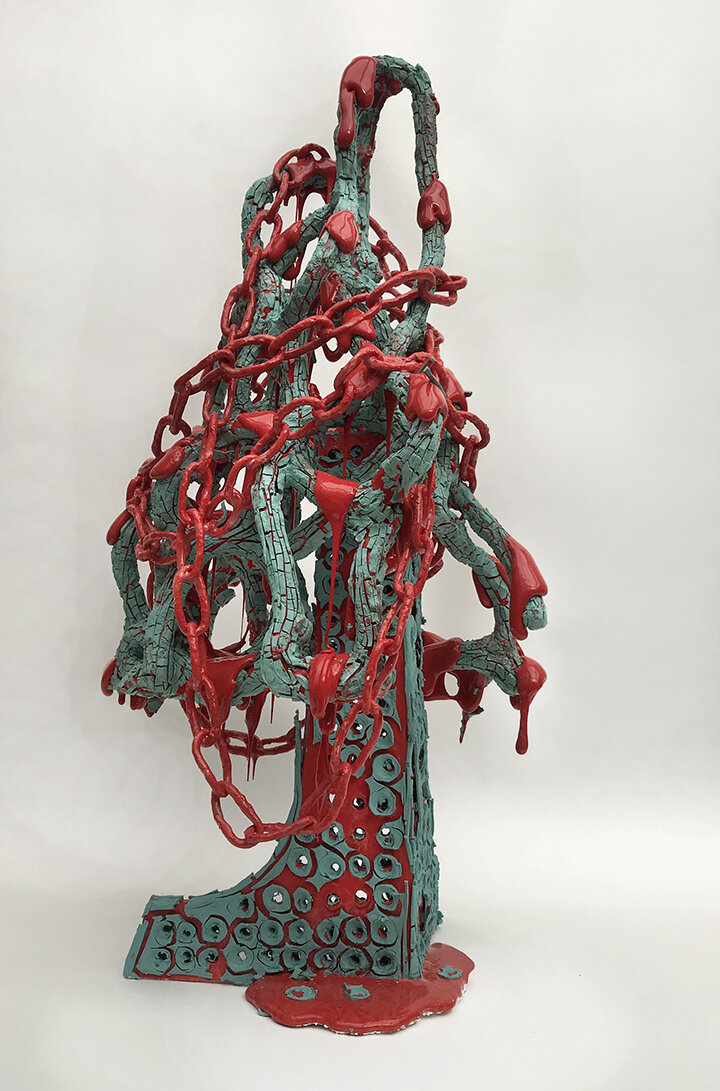aNDREA DU CHATENIER
Whanganui, NEW ZEALAND
Andrea Du Chatenier in her studio, in Whanganui, New Zealand
Andrea Du Chatenier, Arctic Willow, 2019. “This beautiful green mutant is quite big for me—about 800cm tall. The silver was a new glaze and meant I could give the work ‘balls of steel’.”
What leads me now is an addiction to clay and what it can do, not just in terms of technique, but what it can evoke. It’s an ancient material from which some of our first artworks were created, it’s Earth in its most literal form and yet the possibilities of what it can do are still vast. I see clay’s potential as both an archaic form and as a futuristic substance; somewhere between mud and the crystalline, or the organic and the artificial. If I can make people want to reach out and touch—or even better, lick the work—then I’m happy. The sensuality and tactility of the material are nearly as seductive as its alchemy; there is both a science and a magic to the medium. Rather than call it pottery, I like to think of it as magic geology.
Andrea Du Chatenier, Celestial Forest, 2018. Stoneware clay and porcelain. “Most of my work is influenced by the idea of landscape – both real and imaginary – but that is only the starting point. Like landscapes, the textures, colors and combination of form are the visual seduction.”
during the pandemic lockdown, Andrea du chatenier has been making new sculptures from clay and glass that she describes as ‘magic geology’
Andrea Du Chatenier, Rock Face:, 2020. “The individual parts were assembled on the stand to suggest a relic or specimen. It is glazed with colored lava glaze, engobes, and glass.”
Andrea Du Chatenier, Red Tree:, 2020. “I’ve been working with this type of porcelain surface for some time. I color the clay and put it over a gloss surface with the intention of creating shrinkage and intense surface patterns. The chain is a recent addition, used as a formal device to create visual cohesion.”
Andrea Du Chatenier, Dancing Princess, 2020.
Andrea Du Chatenier, Johnson, 2020. “Named for the small town where the Vermont Studio Center is located, where I recently did a residency: it was the first time I’d seen such an intensely snow-covered landscape. Once again, I’ve used porcelain over a high-gloss surface to create a sense of disintegration. To this crisp white surface, I’ve added a thick oozing white glaze, a volcanic glaze and, finally, black-gloss balls to create a contrast of surfaces.
Andrea Du Chatenier, Blood Stack, 2020. “Glazed in a similar manner to Rock Face [shown above], the glazes were layered to create a beautiful red saturation of color.”







![Andrea Du Chatenier, Blood Stack, 2020. “Glazed in a similar manner to Rock Face [shown above], the glazes were layered to create a beautiful red saturation of color.”](https://images.squarespace-cdn.com/content/v1/5e8c1c3c67e74065cc53987c/1592454010126-BWUYSJMQVW8X5K7S22KQ/2.+Andrea+du+Chatenier+Blood+Stack+2020.jpg)